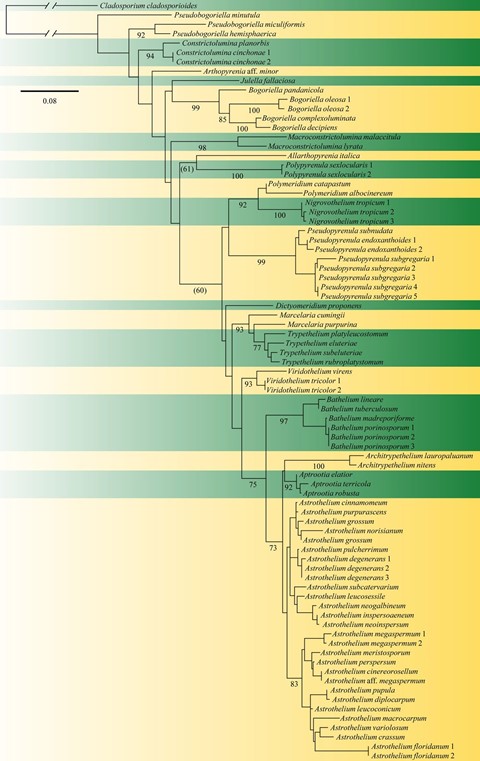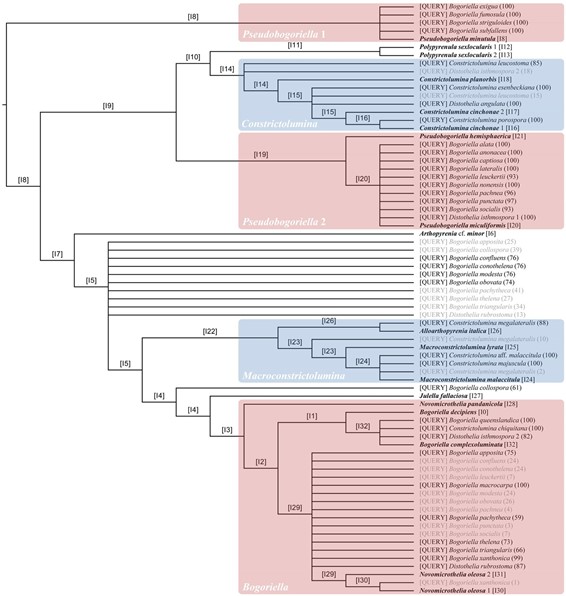Macroconstrictolumina Lücking, R. Miranda & Aptroot, gen. nov.
MycoBank number: MB 836789; Index Fungorum number: IF 836789; Facesoffungi number: FoF 08798;
Four morphologically defined species (this paper); molecular data available for two species (Lücking et al. 2016; this paper).
Diagnosis: Differing from Constrictolumina chiefly in the larger ascospores with granular ornamentation.
Etymology: The name refers to the relatively large ascospores.
Lichenized on bark in terrestrial, chiefly lowland to lower montane tropical habitats. Thallus ecorticate, usually whitish. Photobiont Trentepohlia. Ascomata solitary to rarely aggregate, erumpent to prominent, carbonaceous, ostiolate, ostiole apical to rarely lateral. Involucrellum carbonized. Excipulum prosoplectenchymatous, brownish to colourless below. Hamathecium comprising ca. 1 µm wide pseudo- paraphyses, hyaline, straight, branched and anastomosing, embedded in a gelatinous matrix. Asci 2–8-spored, bitunicate, fissitunicate, clavate, short pedicellate, with a non- amyloid ocular chamber. Ascospores irregularly arranged to biseriate, fusiform-ellipsoid, hyaline, 1(–3)-septate, euseptate, with secondary constrictions in each cell and often with slightly thickened walls, typically granular ornamented, slightly constricted at the septum, with a gelatinous halo, medium-sized [30–50 × 10–16(–24) µm], only in one species (M. lyrata) somewhat smaller. Pycnidia unknown. Chemistry: no substances detected by TLC.
Type species: Macroconstrictolumina malaccitula (Nyl.) Lücking, R. Miranda & Aptroot (see below).
Notes: – This new genus accommodates the lineage phylogenetically separate from the Constrictolumina cinchonae group (Fig. 77), but which had so far been included in that genus (Aptroot and Lücking 2016; Lücking et al. 2016). The difference in ascospore size, in combination with the granular ornamented ascospore wall, appears to be consistent, but further species of both genera need to be sequenced to test this taxonomic hypothesis developed from the binning exercise (Fig. 80).

Fig. 77 Best-scoring maximum- likelihood tree of Trypetheliaceae, showing all currently sequenced and recognized genera, based on the mtSSU marker, with a length of 962 bases. The tree was recon- structed in RAxML 8, using the universal GTR-Gamma model without site partitioning, and the final likelihood was – 7368.672686. The currently accepted genera are highlighted

Fig. 80 Classification tree for non-sequenced species of Bogoriella sensu lato and Constrictolumina sensu lato [QUERY] based on phenotype-based phylogenetic binning into a molecular reference tree of sequenced species (in boldface). Numbers in parentheses behind each query taxon represent bootstrap support for the corresponding placement. Queries with alternative placements supported with less than 70% are greyed out
